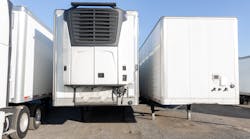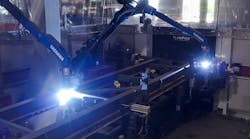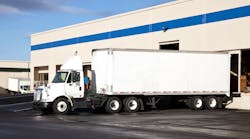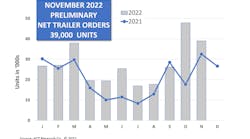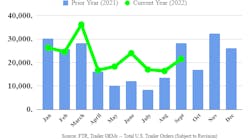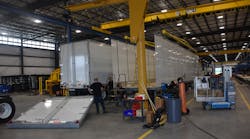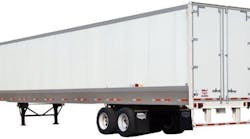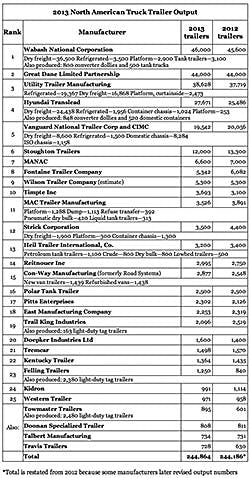The truck trailer manufacturing industry has entered a new era unknown in recent years—a period of stability. For years, the trailer industry has experienced wild swings in demand. Up a few years and down the next. Recently the peaks and valleys have experienced a five-year cycle or some other number depending on trailer type.
The year 2013 may have ended for now the cyclical nature of the trailer industry. The year’s totals of trailer shipments are so similar to 2012 that they are practically identical. And the outlook for 2014 continues the trend.
The top 29 trailer manufacturers built 244,864 truck trailers in 2013. The same 29 leading trailer manufacturers built 244,186 the previous year. The difference is a quarter of one percent (0.27%).
What’s more, many of those same manufacturers are forecasting a flat year in 2014. Or “More of the same.” “Very similar to 2013.” “Up modestly.” “2014 looks like a carbon copy of 2013.”
But it was still a very good year—or two good years. Stability at a high plateau is not a bad thing. It has the potential of being very good for profitable businesses. With less overtime, lower hiring costs, fewer costly layoffs, less inventory build-up, more predictability in purchasing and consequently better planning, a few stable years will let managers concentrate on more efficiency, better designs, and improved profits.
The trailer totals reported here cannot be compared directly with other domestic surveys that do not also include some Canadian and Mexican trailer assembly plants, nor does this survey attempt to cover the many small trailer manufacturing companies located throughout North America.
This Trailer/Body Builders survey is made by telephoning a member of the management team at each manufacturing company. The ranking of the companies does not necessarily reflect their relative success in terms of profitability or revenue received, but only the number of trailers manufactured. The dollar value of a trailer can vary greatly depending on design, type of construction, materials used, and quality level.
Here is how the individual trailer manufacturers performed in 2013:
► Wabash National Corporation had record net sales of $1.64 billion, up 11.9% over the prior year. It also had record operating income of 103.2 million, up 46.4%. It did all this by building and shipping 46,000 trailers, an increase of one percent over 2012. It is also 3.4% less than the 47,600 trailers shipped in 2011.
“We look forward to 2014 with a healthy backlog of orders totaling $711 million” says Dick Giromini, president and CEO, “and a trailer demand forecast well above replacement values for the third consecutive year.”
“As fleet age, customer profitability, used trailer values, regulatory compliance, and access to financing all support continued demand for new trailers,” Giromini continues, “we believe 2014 has the potential to exceed the record financial performances we achieved in 2013.” The breakdown of Wabash National shipments in 2013 by trailer type looks a lot like the 2012 figures except for refrigerated trailers, which were down by 17%. Wabash shipped 3,500 reefers, which is 700 fewer than the 4,200 shipped the previous year.
Wabash shipped 36,500 dry freight vans, a 4% increase over the prior year. Wabash’s Transcraft platforms were down 3% at 2,900 flats. Wabash’s Walker tank trailers were up 3% at 3,100 tankers. This is the first time that Wabash has operated the Walker Group Holdings for a full year after purchasing the Group in May 2012.
Wabash also shipped 800 converter dollies, down 43% from the 1,400 dollies shipped in 2012. These heavy-duty axle units are used in trucking fleets to convert a semi-trailer into a full trailer for operation in a double-trailer train. However, the dollies are not counted as truck trailers. Likewise, Wabash shipped 500 truck-mounted tank bodies, and these truck tanks are not counted in the trailer totals.
► Great Dane Limited Partnership built 44,000 trailers in 2013, the same as the previous year. It was a very stable year overall, but there was some improvement in refrigerated trailer output, now that the new reefer trailer plant in Statesboro, Georgia, has been in production almost two years. It is one of eight plants around the country building Great Dane vans, reefers and platform trailers.
“Looking forward, we think the year 2014 will be very similar to 2013,” says Jon Jeffries, vice-president and general sales manager. “We have a solid backlog, slightly better than last year at this time.”
Jeffries sees no big regulatory threat in the near future that might threaten the relative stability of the industry, other than a concern about what might be included in the new food safety laws and what carriers will have to do to comply with them.
“We had a very good year, and it is continuing,” he says.”We are in a very happy quiet.”
► Utility Trailer Manufacturing in City of Industry, California, had another record-breaking year in 2013, the biggest in their 100-year history. The company built 38,628 trailers, an increase of more than two percent. The build rate was more than 154 trailers a day, figuring 250 work days in a year.
Utility Trailer held onto its title of largest refrigerated trailer manufacturer in the world by building 19,367 reefer trailers, an increase of five percent over their 2013 refrigerated trailer total. That means Utility Trailer built more than half of the refrigerated trailers built by all manufacturers in the United States in 2013.
The dry freight van total for Utility Trailer in 2013 was 16,868, an increase of almost four percent and an all-time company record. Platform and curtainside trailers were down 20% to 2,473 trailers.
The record-breaking production rate continued through the end of 2013 and is also continuing into 2014. “We think the market will remain strong,” says Craig Bennett, senior vice-president, sales and marketing, “and Utility Trailer will have another record year in 2014.”
With five plants regionally placed around the country, the company is ready for that kind of challenge. Utility Trailer has both a dry freight and a refrigerated van plant in Virginia, a dry freight plant in Arkansas, a refrigerated trailer plant in Utah, and the platform/curtainsider plant in Alabama. The family-owned business will be celebrating this year the 100th anniversary of its founding in 1914.
► Hyundai Translead produced 27,671 truck trailers, an 8.6% increase over the 2012 year. Dry freight vans were up 14% to 24,438 trailers, and refrigerated vans were up 85% to 1,956 reefers. Hyundai increased production of their steel and combo platforms 8% to 253 flats. However, container chassis were down 63% to 1,024 chassis.
With corporate headquarters in San Diego, California, Hyundai trailer production is across the border in Tijuana, Mexico. Those plants also turned out 848 converter dollies in 2013, an increase of 15% over the previous year, and 520 domestic containers, down 31%. These dollies and containers are not counted in the truck trailer totals. In terms of total units, Hyundai turned out 29,021 units in 2013, up 7.6%.
“With an improving economy, we think the trailer market will be up modestly in 2014,” says Brett Bartels, deputy general manager, sales and marketing strategy. “Our backlog now in January is 15% higher than it was last year at this time.”
► Vanguard National Trailer Corp is reporting for the first time the container chassis produced by its parent company, CIMC USA. These amounted to 8,284 domestic container chassis and 1,158 ISO container chassis, for a total of 9,442 container chassis produced in 2013 by Vanguard’s sister company, CIMC Intermodal Equipment in South Gate, California.
Refrigerated van trailers assembled by Vanguard National in Monon, Indiana, stayed steady at 1,500. Dry freight vans were off by two percent at 8,600 vans, for a total of 10,100 complete trailers in 2013, versus 10,326 the previous year.
The combined total of CIMC Intermodal chassis and Vanguard National complete trailers in 2013 is 19,542 trailers, reports Charlie Mudd, president of Vanguard National Trailer Corp. This is down 2.5% from the total of 20,056 trailers and chassis in 2012.
► Stoughton Trailers LLC increased its output of van trailers and grain trailers by a thousand trailers (a 9% gain), but did very little in the intermodal market. The total for 2013 is 12,000 truck trailers, almost all vans and some grain trailers.
“We think van trailers will be flat in 2014,” says Bob Wahlin, president of Stoughton, “but we are excited about the growth for us in grain trailers and intermodal.” The reason for that optimism is a new model that was launched during the past year. The Platinum grain trailer has new design improvements, and the dealer network for grain trailers has been expanded.
On the intermodal side, Stoughton has redesigned its domestic container and the production facilities for it, so that it is better able to meet market demands for containers and chassis in 2014. Stoughton builds its intermodal equipment in its Evansville, Wisconsin, plant, while its van and grain trailers are built in Brodhead and the headquarters plant in Stoughton,Wisconsin.
► MANAC of Quebec built 6,600 truck trailers in Canada and the United States, a decline of six percent from 2012. “We had a good year, but we made a decision to no longer build van trailers in the United States,” says Charles Dutil, president. The company builds a mix of vans, flats, and vocational trailers in Canada, plus bottom dump trailers in Kennett, Missouri, and platform trailers in Oran, Missouri.
► Fontaine Trailer Company in Birmingham, Alabama, built 5,342 truck trailers in 2013, down 14% from the previous year. In the two prior years, Fontaine had doubled production, and then followed with a 75% increase.
Heavy haul trailers were up slightly in 2013. The decrease was primarily in platforms. “We are optimistic that with a stronger housing market, that 2014 will mirror 2012 (almost 6,100 units)” says Hank Prochazka, president of Fontaine Trailer Commercial Group.
“It was a good year,” says Dale Jones, president. “It was a record crop year for both corn and soybeans. Now that bumper crop is in storage and has to be moved---hopefully by semitrailers. That has the potential of making 2014 another very good year for grain trailers, even though corn prices are down to about $4.20 from a high of about $7.80 last year.”
Timpte has expanded its sales presence with the opening of a new full-service sales and repair branch in Bloomington, Illinois. “We are already fully staffed with sales, parts counter and service mechanics,” says Jones.
► MAC Trailer Manufacturing of Alliance, Ohio, built 3,526 trailers, down 9.4% from 2012, which had seen a 37% increase over 2011. Dump trailers and refuse transfer trailers were both good, but platform trailer output declined 11%. Pneumatic dry bulk trailers, widely used for hauling frac’ing sand in the oilfield, were down 40%, but liquid tanks were up 6%. The company also built 63 truck bodies mounted on straight trucks, but these are not counted in the trailer total.
Mike Conny, president of MAC trailer, says the liquid tank business was handicapped in 2013 by insufficient large plant equipment to produce type 406 and 407 tanks. That new equipment is now in place to allow ramping up production of both liquid and pneumatic bulk tanks. He expects 2014 to be a strong year.
► Strick Corporation built 3,500 trailers in 2013, down 20%. However, dry freight vans were up 19%. These are sheet-and-post vans in 53-ft and 28-ft lengths built in Strick’s Monroe, Indiana, plant. The goal, says Ben Katz, marketing manager, is to custom design and build vans to solve problems, such as handling heavy loads, bulky or lightweight cargo, or special loading methods.
Platform trailers and forestry equipment built in the Sumter, South Carolina, plant were steady. But container chassis production slumped by almost 50% as Strick continued to move away from the standardized 40-ft chassis to more specialized chassis for a better return.
► Heil Trailer International, Co. of Athens, Tennessee, produced 3,200 tank trailers in 2013, down 16% from the previous year. The total consisted of 1,100 petroleum tank trailers, 800 crude oil tankers, 800 dry bulk trailers, and 500 Kalyn/Siebert lowbed/heavy-haul trailers, reports Jay Morfitt, director of strategic planning and marketing.
Heil also produces tank trailers in the international market, at its plants in Canuelas, Argentina, and Bangkok, Thailand, but these are not counted in the North American totals reported here.
► Reitnouer Inc in Reading, Pennsylvania, built 2,995 all-aluminum platforms, up nine percent from 2012. “We would have built 3,100 but we were closed down the last two weeks of December, and then the first week of January moving into our new plant,” says Bud Reitnouer, president.
Reitnouer Inc is now in a new plant at 5 East Pointe Drive, Birdsboro, Pennsylvania 19508. It is 10 miles away from their old plant in Reading, and is 40% larger. “We will gain 50% in productivity,” says Reitnouer. ”We were building at the rate of 60 a week in December. When we get ramped up in the new plant, we should be able to build 70 to 75 a week.”
For the current 2014 year, the company is looking for about 3,300 to 3,500 trailers. These are all-aluminum, bolted design, flat platforms and drop-deck platforms.
► Con-way Manufacturing (formerly Road Systems Inc) turned out 2,877 trailers in 2013, a 13% increase over the previous year. Half of these were newly manufactured vans and the other half were refurbished. Some 80% were for parent company Con-way Inc, and 20% were for other customers.
Lynn Reinbolt, president of Con-way Manufacturing, says he thinks 2014 will be a carbon copy of 2013.
► Polar Tank Trailer of Holdingford, Minnesota, built 2,500 tank trailers, the same number as in 2012. Some see this leveling out of demand as an indication of the maturing of growth from the oil sector.
Energy will continue to be a growing driver of tank trailer demand, but at a slower rate of growth. “The gold rush mentality is slowing, but crude oil will continue to be robust” says Randy Arlt, vp-sales & marketing. “Downstream, chemicals will continue a 5% growth rate.”
Besides oil and chemicals, Polar continues to build a wide range of tank trailers in steel, aluminum, and stainless steel for the food industry, dairy, agriculture and other industries. It introduced two new tank trailers in 2013, one for hauling anhydrous ammonia and one for propane.
“We are looking for a continuing above-average market in 2014,” says Mark Hunsley, new vice-president sales and marketing as of mid-January. He is a 16-year Polar Trailer veteran who has been running Polar’s 32 service centers, likewise as vp-sales & marketing, until his new assignment on the manufacturing side. “The market won’t be as robust, but it will be a good year.”
► Pitts Enterprises in Pittsview, Alabama, increased output 8%, turning out 2,302 truck trailers in 2013. Forestry trailers from the Pitts Trailer plant in Pittsview were up. Wood chip vans and moving-floor vans from the Dorsey Trailer plant in Elba also contributed to the increase.
Jeff Pitts, president, says the company is planning for about a 10% increase in 2014, and some of that may come from their recently introduced new model---a steel-aluminum combo platform trailer.
► East Manufacturing Company in Randolph, Ohio, built 2,253 all-aluminum truck trailers in 2013, down 3% from the previous year. “Platform trailers were soft in the summer, but rebounded in the fourth quarter,” says David de Poincy, president of East Mfg. “Now we are booking flats into May. We think the market is moving to all-aluminum platforms.”
Dump trailers remained strong in 2013, and refuse trailers moved up in the second half. That leads de Poincy to predict a good year in 2014, perhaps up 5% to 8%. “Our goal is to build 2,500 trailers.”
► Trail King Industries in Mitchell, South Dakota and West Fargo, North Dakota, built 2,096 truck trailers in 2013, down 17%. In addition, the company turned out 163 light-duty tag trailers not counted in the truck trailer total.
Actually, Trail King’s main product line of lowbeds and heavy-hauler trailers was up nine percent. However, dry bulk pneumatics, and bottom dumps and side dump trailers were all down, reflecting a slow construction industry and problems in the oilfield environment with frac’ing.
“We think 2014 will be a stable year,” says Gene Astolfi, CFO, “but we think the dry bulk pneumatics will bounce back, as well as improving sales of bottom dump and side dump trailers.”
► Doepker Industries in Anaheim, Saskatchewan, Canada, had a good year in all five sectors of their production: oilfield equipment, agricultural trailers, flatbeds, gravel haulers, and forestry equipment. The company built 1,600 trailers in 2013, a 14% increase.
“We hope to climb back up to the 1,800-trailer level in 2014,” says Bill Schuler, vp-marketing and sales.
A new model bottom-dump ag bulker now being introduced in local trade shows may help Doepker reach that goal. It is an all-aluminum Super B-train that has a payload of 45 metric tonnes (99,000 lb). Tare weight is 19,500 lb. The five axles all have dual wheels. The lead tailer has three axles, and the following trailer has two axles. Overall length of the Super B-train is 62 feet.
► Tremcar Inc with three plants located in Montreal and Toronto, Canada, and Strasburg, Ohio, built 1,498 tank trailers, a five percent decline from its 2013 output. “It was a stable year,” says Daniel Tremblay, president. “We expect much the same in the coming year. We see increases in chemical trailers, and also an improvement in dry bulk trailers for hauling cement. We think the housing market will be improving and need more concrete.”
► Kentucky Trailer in Louisville built 1,364 trailers in 2013, off 5%. Most of these are dropframe vans for the household goods moving industry, but a growing number are used for outfitting specialized mobile command and control centers, says Larry Roy, executive vice-president. A subsidiary company, Kentucky High Performance Trailers, finishes out Kentucky vans for mobile medical centers, on-site broadcast booths, and sporting events.
Kentucky Trailer also opened a third service center for repair and maintenance of their regular vans and high performance trailers, this one in the Detroit area.
► Felling Trailers of Saux Centre, Minnesota, built 1,250 truck trailers, a 49% increase over 2012, which also had been a big increase (48%) over their 2011 output. The company also built 2,380 light-duty trailers with individual axle capacities under 10,000 lb. This was a 14% increase over 2012 light-duty trailer production.
Patrick Jennissen, vp-sales & marketing, said a year ago that Felling Trailers was predicting a 25% to 30% increase in 2013, so the 49% increase far exceeded that outlook. For the coming year, the company is forecasting a flat year to modest gains of less than 10%.
Felling produces both light-duty and heavy-duty tag trailers and heavy-duty semitrailers up to 120-ton lowbeds. Its hydraulic detachable gooseneck lowbed is in heavy demand, as well as hydraulic tail trailers. Also popular are its 48-ft steel dropdeck trailers for hauling farm equipment and hay.
► Kidron of Kidron, Ohio, built 991 refrigerated trailers, mainly for the foodservice industry. This is 123 trailers fewer than the 2012 build, primarily because of customer merger activity. However, the company more than made up for the decline by expansion of sales of its refrigerated truck bodies, says John Sommer, executive vice-president
The same Kidron plant in Montgomery, Pennsylvania, that builds refrigerated truck trailers up to 53 feet long also builds insulated and refrigerated truck bodies. Kidron also builds refrigerated truck bodies in its headquarters plant in Kidron, Ohio, and in a new plant in Independence, Kansas.
► Western Trailer in Boise, Idaho, built 971 truck trailers, a gain of only one percent. That slight increase made it a very good year, because it started awfully slow. After the first quarter, though, business started building, and it has been building ever since. The increased momentum will make 2014 a great year, says Tod Swanstrom, engineering manager. Platform trailers led the increase last year at Western Trailer, and they are continuing strong in 2014. Ag trailers and wood residue trailers were also very good.
► Towmaster Trailers of Litchfield, Minnesota, built 895 truck trailers in 2013, a 49% increase over the previous year. These include equipment trailers, platforms, drop-decks, hydraulic tail and tilt decks up to heavy-haul lowbeds. Not counted in these heavier categories are 2,480 light-duty tag trailers with individual axle capacities under 10,000 lb.
“Business activity is steady at this time, but we are anticipating an increase just before Spring arrives,” says Chris Pokornowski, national sales manager. “Overall, we are projecting an increase in business of 12% for 2014.”
► Doonan Specialized Trailer in Great Bend, Kansas, had a good year in 2013, flat with the previous year. Doonan built 808 trailers almost the same as the 811 in 2011.
“We have had two good years,” says Mike Gordy, president. “We’re looking forward to another in 2014.”
To maintain that momentum, Doonan is up-grading its Chaparral aluminum platform line and looking to introduce a new product in the Doonan steel platform or lowbed sector.
► Talbert Manufacturing in Rensselaer, Indiana, built 734 truck trailers, about the same as in 2012. However, the mix of lowbeds for construction and for oilfield service was higher than ag equipment trailers. These heavier trailers require more labor hours and production time, and result in higher revenue.
“We are expecting about the same number in 2014,” says Greg Smith, vice-president sales and marketing, “but we are also cautiously optimistic.” Talbert is now introducing a new model, a 55-ton, low deck height (18 inches) lowbed with three axles plus an optional equalizer axle.
“Trailer manufacturers are being forced to come up with new designs to fit larger oversize loads under existing bridges, while maintaining a high level of strength. There’s a continuous push for lighter trailer weights and lower deck heights with the strength to haul heavy loads.”
► Travis Trailers in Houston increased production 16% in 2013, building 728 aluminum dump trailers, bottom dumps, and refuse transfer trailers. Almost a fifth of these were Alumatech end dumps, a super-lightweight product line that Travis acquired in 2011 from Everlite, Inc in Longview.
Bud Hughes, president of Travis Trailers, is predicting a ten percent increase in sales in 2014 because of the positive outlook for continuing slow growth all across the economy, and, of course, the increased oilfield activity.
